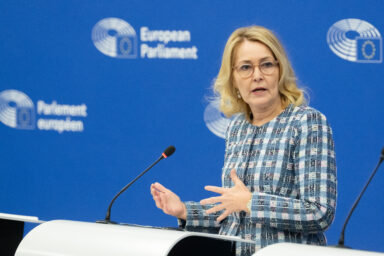The European Parliament and the Council of the EU reached a provisional agreement to make transactions in transferable securities more efficient through accelerating the settlement cycle. As if to prove the bloc’s financial mettle, the Commission borrowed €5bn at an oversubscription rate of just shy of 19 times.
The Council of the EU and the European Parliament agreed on 18 July to shorten the post-trade settlement cycle for securities transactions—such as shares and bonds—from two business days (T+2) to one (T+1). The amendment to the Central Securities Depositaries Regulation (CSDR), which originally harmonised EU settlements at T+2 in 2014, will apply from 11 October 2027. The shift aligns the bloc with global markets like the US, which moved to T+1 in 2024, and aims to address inefficiencies flagged in recent reports by former EU leaders Mario Draghi and Enrico Letta.
Implementation hurdles
Negotiators exempted securities financing transactions (SFTs)—repurchase agreements and similar instruments used to collateralise short-term funding—from the T+1 rule, provided they are structured as single linked operations. The exemption seeks to prevent regulatory arbitrage while preserving liquidity for financial institutions.
Faster settlements mean stronger markets and a more competitive EU. Andrzej Domanski, Polish minister for finance
The T+1 settlement reform, proposed by the Commission in February 2025, now requires formal adoption by legislators. While the move aims to reduce counterparty risk and align with global standards, operational challenges loom. Central securities depositories—such as Euroclear and Clearstream—must upgrade legacy systems to meet the 2027 deadline, a process complicated by fragmented national infrastructures. Smaller brokers warn of liquidity strains due to accelerated margin calls.
Investor confidence
„This is a win for the Polish Presidency. We led the push to shorten the settlement cycle from T+2 to T+1, meaning trades in shares or bonds will now be settled in one day instead of two. Faster settlements mean stronger markets and a more competitive EU,“ Andrzej Domanski, Polish minister for finance, offered an enthusiastic comment.
The agreement followed a 17 June announcement by the European Commission of a €5 billion syndicated bond issuance, its sixth transaction of 2025. The 15-year bond, a tap of an existing issue maturing in 2039, drew €93 billion in bids—an oversubscription rate of nearly 19 times—and priced at a yield of 3.445%. Proceeds will fund NextGenerationEU projects and support for Ukraine, bringing the Commission’s 2025 borrowing to €80 billion. A final €6 billion auction on 23 June will conclude the semester’s funding.
Since 2023, the EU has issued “single-branded” EU-Bonds, replacing programme-specific debt (e.g., SURE, NGEU) to streamline liquidity. All borrowings are backed by the EU budget, with member states legally obligated to cover liabilities under the treaties.
You might be interested
The issuance underscores investor confidence in the EU’s creditworthiness amid tighter monetary conditions. However, long-term questions persist: the €800 billion NextGenerationEU programme expires in 2026, and Ukraine-related borrowing lacks an explicit end date.
Broader implications
Both initiatives reflect Brussels’ push to modernise capital markets while leveraging joint debt to address crises. The T+1 reform marks incremental progress in the stagnant capital markets union (CMU) project, though deeper integration—such as harmonising insolvency rules—remains elusive. Similarly, the EU’s borrowing strategy faces political headwinds, with frugal states opposing permanent joint debt instruments.
The week’s deals highlight the EU’s balancing act: marrying regulatory pragmatism with fiscal ambition. While the T+1 shift signals responsiveness to global trends, its delayed implementation timeline risks ceding competitive ground. Conversely, robust demand for EU debt validates the bloc’s crisis-era fiscal unity, even as debates over its permanence intensify. For Brussels, the path forward hinges on aligning market modernisation with political realism—a task as urgent as it is fraught.











